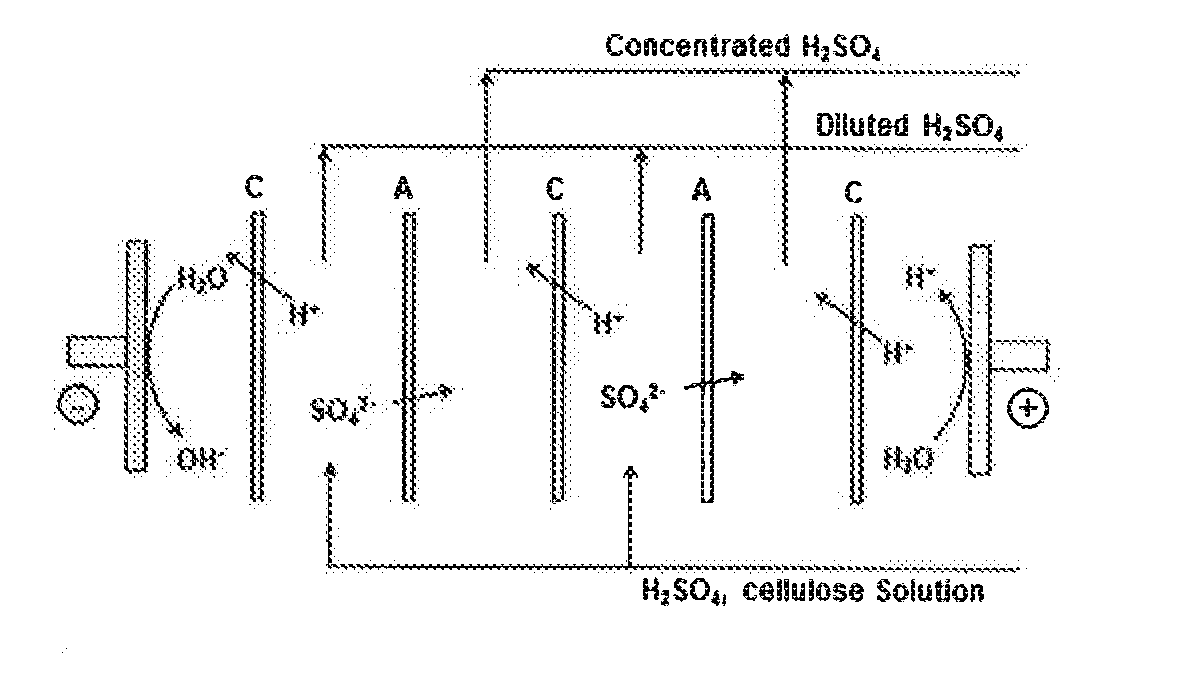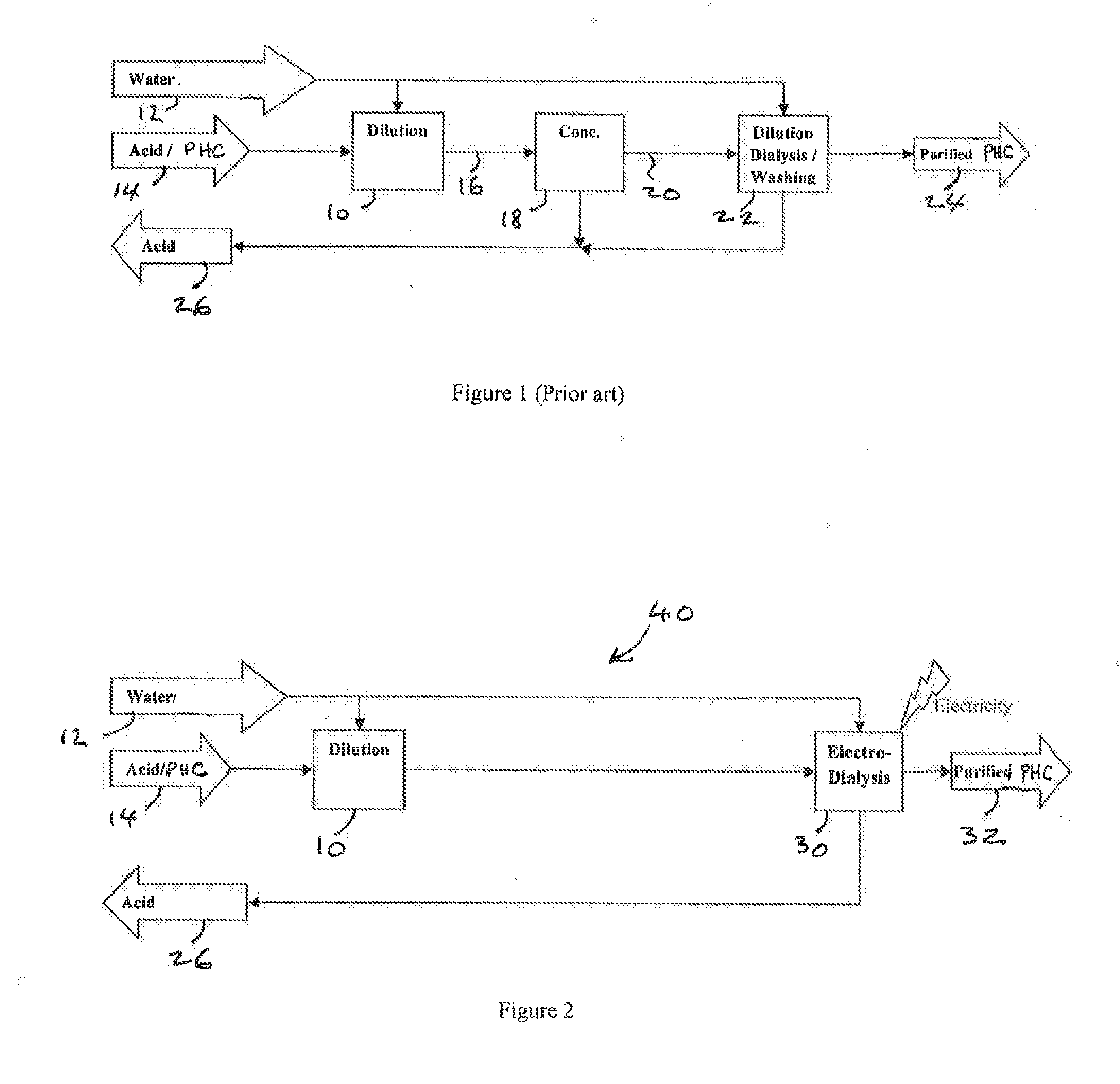Purification process for partly-hydrolyzed cellulose
a technology of partly hydrolyzed cellulose and purification process, which is applied in the field of washing partly hydrolyzed cellulose, can solve the problems of affective electrolysis, and achieve the effect of reducing requirements and high capital and operating costs
- Summary
- Abstract
- Description
- Claims
- Application Information
AI Technical Summary
Benefits of technology
Problems solved by technology
Method used
Image
Examples
example 1
Cation / Anion Cell Configuration
[0050]In a first experiment, an open cell configuration was utilized due to the fear of solids pluggage in the cell and potential fouling of the membrane. This test cell incorporated Neosepta CMX cation and Asahi AAV anion membranes. C, A respectively, as illustrated schematically in FIG. 7, showing 2 cells. The AAV membrane A is a specialty membrane developed to help prevent proton back-migration. In the FIG. 7 configuration, the sulfate travels across the anion membrane. This removes the sulfate from the feed solution, which then combines with the proton crossing the cation membrane to increase the acid strength in the receiving compartment. The cell was charged at a constant 3.2 V across the platinum wire probes (four cation and four anion membranes).
[0051]FIG. 8 shows the voltage and current density throughout the run. Although a relatively high current density of 25 mA / cm2 was first obtained, it decreased considerably to about 2 mA / cm2 by the end ...
example 2
Bipolar / Anion Cell Configuration
[0052]in a second experiment, the CMX membrane in the Example 1 cell was replaced by a Neosepta BP-1E bipolar membrane B, as depicted in FIG. 11. This bipolar membrane splits water at low voltage to produce protons on the cathode facing side of the membrane and hydroxide on the anode facing side. In this case the proton in the cellulose solution does not need to be free but is “titrated” by hydroxide produced at the membrane surface. The sulfate is transported similarly to the Example 1 configuration. The bipolar membrane needs to run at a voltage of at least 1 V, and therefore a voltage of 1.4 V / cell was used (Pt-Pt voltage of 5.6 V over the four bipolar and four anion membranes).
[0053]The power supply used for these tests had a voltage limit of 10 V, which initially limited the Pt-Pt voltage as the end voltages were high (5 volts total). FIG. 12 shows the voltage and current density profiles. As the current density dropped so did the end voltages. A...
example 3
Bipolar / Anion Cell Configuration with Anion Exchange Resin
[0055]Given that solids pluggage and fouling was not observed in the open cell configuration a subsequent experiment was performed using a similar cell build, but with the feed compartment filled with an anion exchange resin (Supelco Amberlite IRA400). The use of ion exchange resin in this compartment was intended to boost the solution conductivity and help facilitate the transfer of sulfate in this compartment by increasing the local concentration of anion (sulfate). The resin was first converted to the hydroxide form by soaking in NaOH and rinsed with DI water before being added to the cell. The cell was built with BP-1E bipolar and AAV anion membranes in the same configuration as FIG. 11. The active area of the feed flow frames were filled with the resin and the inlet and outlet channels of the frames were filled with glass wool to retain the resin within the cell. As with the Example 2 test with bipolar membrane, the tota...
PUM
| Property | Measurement | Unit |
|---|---|---|
| size | aaaaa | aaaaa |
| temperature | aaaaa | aaaaa |
| conductivity | aaaaa | aaaaa |
Abstract
Description
Claims
Application Information
 Login to View More
Login to View More - R&D
- Intellectual Property
- Life Sciences
- Materials
- Tech Scout
- Unparalleled Data Quality
- Higher Quality Content
- 60% Fewer Hallucinations
Browse by: Latest US Patents, China's latest patents, Technical Efficacy Thesaurus, Application Domain, Technology Topic, Popular Technical Reports.
© 2025 PatSnap. All rights reserved.Legal|Privacy policy|Modern Slavery Act Transparency Statement|Sitemap|About US| Contact US: help@patsnap.com



